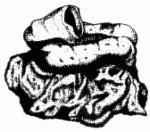See the flat earth thread :tinfoil:so basically its easier for us to build rocket ships to fly outside of the planet and play around in space then it is for us to go to far into the ocean. crazy.
You are using an out of date browser. It may not display this or other websites correctly.
You should upgrade or use an alternative browser.
You should upgrade or use an alternative browser.
The Ocean is Way Deeper Than You Think
- Thread starter morris
- Start date
More options
Who Replied?i spend time out on the open seas for my job. it's humbling to go outside sometimes and look at the open horizon. the whole idea of it is crazy....unfathomably large body of water, whose waves are controlled by the gravitational pull from a rock and some burning gas 100000s of miles away. 
i sometimes get freaked out when i'm out there and think....if i slip and fall off right now, they ain't finding me

i sometimes get freaked out when i'm out there and think....if i slip and fall off right now, they ain't finding me

Last edited:
Marco Zen
Black Privilege
i use to be the first one to say we need to get in that ocean . but after watching this I might have to side with you. maybe that stuff is better left alone. But...But..what if their's a cure for a bunch of diseases down there Not that the big companies would give it to the patient's. they would just dumb down the potency and slang it as medicine to keep you barely hanging on.fukk that. Let them sleep. Whatever's down there doesn't need to be trifled with. You want to bring up Leviathans and Beelzebubs and such?
to say that space exploration is better than ocean is the stupidest thing I've ever heard. How would you know this if you've never gone but X far in the ocean?Space exploration > ocean. I guarantee that the government has more info on life outside planet earth than they're admitting.
You see those strange looking fish. no tellin whats down there. what we do know so far is that their aint a darn thing on the moon. not one thing. we assume nothing can survive on venus, mercury. They just said Jupiter has cyclones as large as a planet. Now we know you aint surviving that. so probably nothing to see there either. You over here looking for aliens and you have them right in your own back yard.
This is PERFECT for a horror film.
Self_Born7
SUN OF MAN
right,,, we know more and explored the moon more than our oceans,,, which is strange since were surround 3/4 of water.Amazing. There is still so much we don't know about the ocean.
MikeyC
The Coli Royal Rumble Champion 2019
to say that space exploration is better than ocean is the stupidest thing I've ever heard. How would you know this if you've never gone but X far in the ocean?
You see those strange looking fish. no tellin whats down there. what we do know so far is that their aint a darn thing on the moon. not one thing. we assume nothing can survive on venus, mercury. They just said Jupiter has cyclones as large as a planet. Now we know you aint surviving that. so probably nothing to see there either. You over here looking for aliens and you have them right in your own back yard.
Fam, space exploration is a lot more than just looking for aliens.
Kingshango
Veteran
I still think there's some massive creature in the deepest parts of the ocean that does NOT wanna be awoken.

dontreadthis
philly.
lol I wonder what kind of shyt we would see if we could actually get a machine all the way to that bottom and shine a big ass 360 light around and film for a littleWe went into the trench but never touch the bottom. We still can figure out how to protect equipment from pressurization after x amount of km under sea. There's something like 15,000 psi for every km you go down...its insane. It will be a long time before we reach the "bottom" and even then it's going to become a matter of having the tools to explore it properly.

Mars Blackmon
Pro
Nikka you sound stupid. You're talking about 3 or 4 planets when there's literally an infinite amount of them. Hopefully in thousands of years or whenever when we need to colonize another planet they'll be people smart enough to put more resources into space exploration instead of trying to see rare ugly ass fish.to say that space exploration is better than ocean is the stupidest thing I've ever heard. How would you know this if you've never gone but X far in the ocean?
You see those strange looking fish. no tellin whats down there. what we do know so far is that their aint a darn thing on the moon. not one thing. we assume nothing can survive on venus, mercury. They just said Jupiter has cyclones as large as a planet. Now we know you aint surviving that. so probably nothing to see there either. You over here looking for aliens and you have them right in your own back yard.

Got damn, at least one other person gets it.Fam, space exploration is a lot more than just looking for aliens.
lol I wonder what kind of shyt we would see if we could actually get a machine all the way to that bottom and shine a big ass 360 light around and film for a little

The light illuminates and you see this mammoth boulder that resembles an eyelid....
Then the eyelid opens

The light illuminates and you see this mammoth boulder that resembles an eyelid....
Then the eyelid opens
 I gotta go back to sleep
I gotta go back to sleepthis thread inspired me to look up the types of dangerous fish/sea creatures i'd be likely to encounter in Hawaii, where i frequently snorkel....
 i didn't realize half of the fish I see all the time can injure me...
i didn't realize half of the fish I see all the time can injure me...
 Cone Snail
Cone Snail
COMMON HABITAT Tide pools, sandy areas, shallow to deep offshore waters.
PREVENTION Do not handle (even with gloves), especially near tip.
INJURY MECHANISM Poisonous, dart-like mechanism near tip used for stunning and killing fish and invertebrates.
SIGNS AND SYMPTOMS Stinging, burning pain, numbness, coma or cardiac arrest.
FIRST AID TREATMENT Scrub the wound. Get medical help for severe reactions.
 Moray Eel
Moray Eel
COMMON HABITAT Rocky areas, in holes, under rocks, crevices and tide pool ledges.
PREVENTION Keep hands out of rocky areas, holes and crevices. Use stick to probe. Dead fish, blood or bait will bring them out of their holes.
INJURY MECHANISM Razor sharp teeth, powerful jaws.
SIGNS AND SYMPTOMS Bleeding, severe muscle damage, but more commonly tendon and nerve damage.
FIRST AID TREATMENT Stop bleeding with pressure, clean thoroughly. Get medical help (guard against infection).
 Needle Fish I've seen these a lot....never knew they could puncture skin.
Needle Fish I've seen these a lot....never knew they could puncture skin. 
COMMON HABITAT Near surface in bay areas and open waters.
PREVENTION Use caution when night lighting/fishing.
INJURY MECHANISM Long pointed jaw.
SIGNS AND SYMPTOMS Pointed jaw may puncture and break off leaving a puncture wound.
FIRST AID TREATMENT If point doesn't break off, clean with antiseptic if stabbed. If point breaks off do not remove it. Stop any bleeding with pressure. Get medical help immediately!

Sea Urchin
COMMON HABITAT Shallow reef areas to 100 foot depths.
PREVENTION Wear foot protection. Don't walk on rocky areas with poor visibility. Do not handle!
INJURY MECHANISM Long, extremely brittle spines.
SIGNS AND SYMPTOMS Throbbing pain. Purplish discoloration.
FIRST AID TREATMENT Pull out protruding spines. If spines(s) is/are in a joint, nerve, or when wound is infected - get medical help.
 swim with these all the time
swim with these all the time
Surgeonfish
COMMON HABITAT Wave zone to 150 foot depths.
PREVENTION Take care in handling.
INJURY MECHANISM Spine and knife-like razors near tail.
SIGNS AND SYMPTOMS Throbbing pain, itching, bleeding and numbness.
FIRST AID TREATMENT Stop bleeding with pressure, clean thoroughly with soap and water. Get medical treatment for deep cuts and embedded spine pieces. Do not try to remove pieces yourself.

Tube Worm
COMMON HABITAT Shallow reef areas.
PREVENTION Use protective footwear and gloves.
INJURY MECHANISM Hardened, razor sharp opening to worm's shelter.
SIGNS AND SYMPTOMS Circular cut with fragments that may be embedded. Bleeding.
FIRST AID TREATMENT Stop bleeding with pressure, clean thoroughly with soap and water. Get medical treatment for deep cuts and embedded pieces. Do not try to remove pieces yourself.
 i didn't realize half of the fish I see all the time can injure me...
i didn't realize half of the fish I see all the time can injure me...
COMMON HABITAT Tide pools, sandy areas, shallow to deep offshore waters.
PREVENTION Do not handle (even with gloves), especially near tip.
INJURY MECHANISM Poisonous, dart-like mechanism near tip used for stunning and killing fish and invertebrates.
SIGNS AND SYMPTOMS Stinging, burning pain, numbness, coma or cardiac arrest.
FIRST AID TREATMENT Scrub the wound. Get medical help for severe reactions.

COMMON HABITAT Rocky areas, in holes, under rocks, crevices and tide pool ledges.
PREVENTION Keep hands out of rocky areas, holes and crevices. Use stick to probe. Dead fish, blood or bait will bring them out of their holes.
INJURY MECHANISM Razor sharp teeth, powerful jaws.
SIGNS AND SYMPTOMS Bleeding, severe muscle damage, but more commonly tendon and nerve damage.
FIRST AID TREATMENT Stop bleeding with pressure, clean thoroughly. Get medical help (guard against infection).


COMMON HABITAT Near surface in bay areas and open waters.
PREVENTION Use caution when night lighting/fishing.
INJURY MECHANISM Long pointed jaw.
SIGNS AND SYMPTOMS Pointed jaw may puncture and break off leaving a puncture wound.
FIRST AID TREATMENT If point doesn't break off, clean with antiseptic if stabbed. If point breaks off do not remove it. Stop any bleeding with pressure. Get medical help immediately!

Sea Urchin
COMMON HABITAT Shallow reef areas to 100 foot depths.
PREVENTION Wear foot protection. Don't walk on rocky areas with poor visibility. Do not handle!
INJURY MECHANISM Long, extremely brittle spines.
SIGNS AND SYMPTOMS Throbbing pain. Purplish discoloration.
FIRST AID TREATMENT Pull out protruding spines. If spines(s) is/are in a joint, nerve, or when wound is infected - get medical help.


Surgeonfish
COMMON HABITAT Wave zone to 150 foot depths.
PREVENTION Take care in handling.
INJURY MECHANISM Spine and knife-like razors near tail.
SIGNS AND SYMPTOMS Throbbing pain, itching, bleeding and numbness.
FIRST AID TREATMENT Stop bleeding with pressure, clean thoroughly with soap and water. Get medical treatment for deep cuts and embedded spine pieces. Do not try to remove pieces yourself.

Tube Worm
COMMON HABITAT Shallow reef areas.
PREVENTION Use protective footwear and gloves.
INJURY MECHANISM Hardened, razor sharp opening to worm's shelter.
SIGNS AND SYMPTOMS Circular cut with fragments that may be embedded. Bleeding.
FIRST AID TREATMENT Stop bleeding with pressure, clean thoroughly with soap and water. Get medical treatment for deep cuts and embedded pieces. Do not try to remove pieces yourself.
Cat piss martini
Veteran
there are things in the ocean we never
wanna find....


wanna find....

